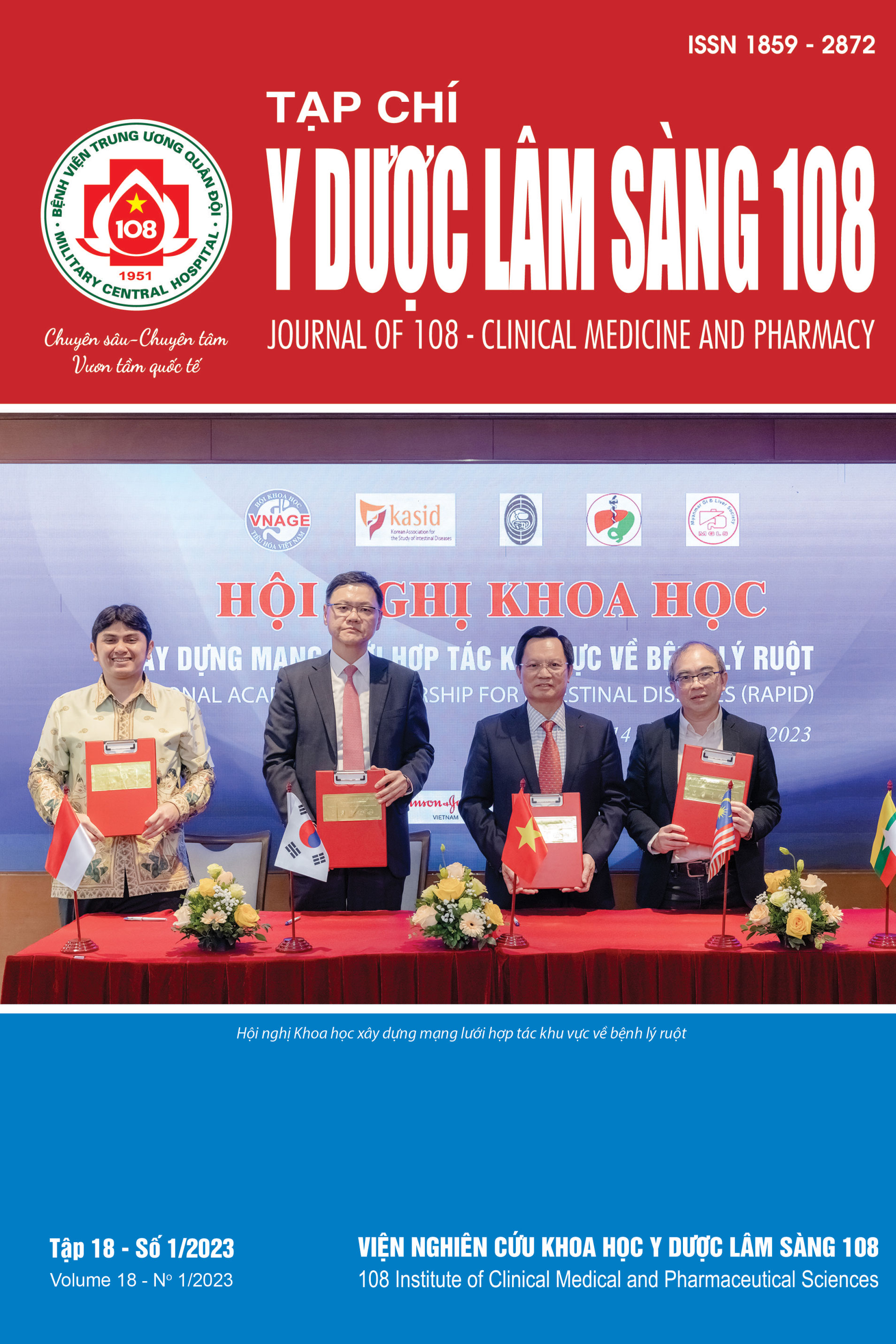Đánh giá khả năng gắng sức ở bệnh nhân suy tim phân suất tống máu bảo tồn bằng nghiệm pháp gắng sức thảm chạy
Main Article Content
Keywords
Tóm tắt
Mục tiêu: Đánh giá khả năng gắng sức ở bệnh nhân suy tim phân suất tống máu bảo tồn bằng bài tập vận co cơ động trên thảm chạy. Đối tượng và phương pháp: Nghiên cứu cắt ngang mô tả tiến hành trên 50 bệnh nhân được chẩn đoán suy tim phân suất tống máu bảo tồn điều trị tại Viện Tim mạch Việt Nam - Bệnh viện Bạch Mai. Đánh giá sự thay đổi về tần số tim, mức độ gắng sức và mức tiêu thụ oxy tối đa khi gắng sức và sau gắng sức bằng thảm chạy. Kết quả: Bệnh nhân có độ tuổi trung bình 50 ± 13,9 (24-71 tuổi) với phân suất tống máu trung bình 56,6 ± 3,2% được thực hiện bài tập trên thảm chạy trong thời gian trung bình 1041 ± 318 giây. Kết quả cho thấy mức độ gắng sức trung bình của các bệnh nhân là 13,0 ± 3,9 (METs) với mức tiêu thụ oxy tối đa VO2 max là 62,3 ± 19,9 (ml/kg/phút). Sau gắng sức, giá trị hồi phục nhịp tim sau 1 phút là 29,6 ± 14,5 (nhịp/phút). Khả năng gắng sức có tương quan tuyến tính với giá trị phục hồi nhịp tim với r = 0,436 (p<0,05). Kết luận: Giá trị hồi phục nhịp tim trên đối tượng người Việt Nam có suy tim phân suất tống máu bảo tồn đo được sau gắng sức 1 phút có tương quan tuyến tính thuận với khả năng gắng sức METS. Đồng thời, chưa tìm thấy mối liên hệ giữa giá trị hồi phục nhịp tim với các yếu tố khác như giới, phân suất tống máu EF và mức tiêu thụ oxy tối đa.
Article Details
Các tài liệu tham khảo
2. Nguyễn Thị Thu Hoài, Phan Đình Phong, Phạm Mạnh Hùng (2019) Nghiên cứu khả năng dung nạp với gắng sức ở các bệnh nhân đái tháo đường type 2 bằng phương pháp điện tâm đồ gắng sức thảm chạy. Tạp chí Tim mạch học Việt Nam số 86; 2019, tr. 97-103.
3. Nguyễn Đỗ Quân, Lê Đình Tùng (2020) Đặc điểm phục hồi nhịp tim sau bài tập vận cơ tĩnh và động ở người bình thường và ở bệnh nhân suy tim. Luận văn Thạc sĩ y học, Trường Đại học Y Hà Nội.
4. Buch AN, Coote JH, Townend JN (2002) Cardiac vagal control and physical training-what’s the link? Exp Physiol 87: 423-435.
5. Gerritsen J, Dekker JM, Tenvoorde BJ et al (2001) Impaired autonomic function is associated with increased mortality, especially in subjects with diabetes, hypertension, or a history of cardiovascular disease: The hoorn study. Diabetes Care 24(10): 1793-1798. doi: 10.2337/diacare.24.10.1793.
6. Sacre JW, Jellis C, Coombes J, Marwick T (2012) Diagnostic accuracy of heart-rate recovery after exercise in the assessment of diabetic cardiac autonomic neuropathy. Diabet Med 29: 312-320.
7. Buchheit M, Papelier Y, Laursen PB, Ahmaidi S (2007) Noninvasive assessment of cardiac parasympathetic function: Postexercise heart rate recovery or heart rate variability? Physiol Heart Circ Physiol 293: 8-10.
8. Morshedi-Meibodi A, Larson MG, Levy D, O'Donnell CJ, Vasan RS (2002) Heart rate recovery after treadmill exercise testing and risk of cardiovascular disease events (The Framingham Heart Study). Am J Cardiol 90: 848-852.
9. Racine N, Blanchet M, Ducharme A et al (2003) Decreased heart rate recovery after exercise in patients with congestive heart failure: Effect of beta-blocker therapy. J Card Fail 9: 296-302.
10. Ba A, Delliaux S, Bregeon F, Levy S, Jammes Y (2009) Post-exercise heart rate recovery in healthy, obeses, and COPD subjects: Relationships with blood lactic acid and PaO2 levels. Clin Res Cardiol 98: 52-58.
11. McDonagh TA, Metra M, Adamo M et al (2021) 2021 ESC Guidelines for the diagnosis and treatment of acute and chronic heart failure. European Heart Journal 12 (36): 3599-3726.
12. Lang RM, Badano LP, Mor-Avi V (2015) Recommendations for Cardiac Chamber Quantification by Echocardiography in Adults: An Update from the American Society of Echocardiography and the European Association of Cardiovascular Imaging. J Am Soc Echocardiogr 28: 1-39.
13. Nagueh S, Smiseth OA, Appleton CP (2016) Recommendations for the Evaluation of Left Ventricular Diastolic Function by Echocardiography: An Update from the American Society of Echocardiography and the European Association of Cardiovascular Imaging. J Am Soc Echocardiogr 29: 277-314.
14. Erdogan D, Gonul E, Icli A et al (2011) Effects of normal blood pressure, prehypertension, and hypertension on autonomic nervous system function. Int J Cardiol 151: 50-53.
15. Cole CR, Foody JM, Blackstone EH, Lauer MS (2000) Heart rate recovery after submaximal exercise testing as a predictor of mortality in a cardiovascularly healthy cohort. Ann Intern Med 132: 552-555.
16. Vivekananthan DP, Blackstone EH, Pothier CE, Lauer MS (2003) Heart rate recovery after exercise is a predictor of mortality, independent of the angiographic severity of coronary disease. J Am Coll Cardiol 42: 831-838.
17. Kaye DM, Esler MD (2008) Autonomic control of the aging heart. Neuromolecular Med 10: 179-186.
 ISSN: 1859 - 2872
ISSN: 1859 - 2872
